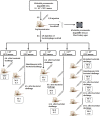Evaluation of Bacteriophage Cocktail on Septicemia Caused by Colistin-Resistant Klebsiella pneumoniae in Mice Model
- PMID: 35197852
- PMCID: PMC8860340
- DOI: 10.3389/fphar.2022.778676
Evaluation of Bacteriophage Cocktail on Septicemia Caused by Colistin-Resistant Klebsiella pneumoniae in Mice Model
Abstract
Objective: The emergence of resistance against last-resort antibiotics, carbapenem and colistin, in Klebsiella pneumoniae has been reported across the globe. Bacteriophage therapy seems to be one of the most promising alternatives. This study aimed to optimize the quantity and frequency of bacteriophage cocktail dosage/s required to eradicate the Klebsiella pneumoniae bacteria in immunocompetent septicemic mice. Methods: The three most active phages ɸKpBHU4, ɸKpBHU7, and ɸKpBHU14 characterized by molecular and TEM analyses were in the form of cocktail and was given intraperitoneally to mice after inducing the septicemia mice model with a constant dose of 8 × 107 colony-forming unit/mouse (CFU/mouse) Klebsiella pneumoniae. After that, the efficacy of the phage cocktail was analyzed at different dosages, that is, in increasing, variable, constant, and repeated dosages. Furthermore, interleukin-6 and endotoxin levels were estimated with variable doses of phage cocktail. Results: We have elucidated that phage therapy is effective against the Klebsiella pneumoniae septicemia mice model and is a promising alternative to antibiotic treatments. Our work delineates that a single dose of phage cocktail with 1 × 105 plaque-forming unit/mouse (PFU/mouse) protects the mice from fatal outcomes at any stage of septicemia. However, a higher phage dosage of 1 × 1012 PFU/mice is fatal when given at the early hours of septicemia, while this high dose is not fatal at the later stages of septicemia. Moreover, multiple repeated dosages are required to eradicate the bacteria from peripheral blood. In addition, the IL-6 levels in the 1 × 105 PFU/mouse group remain lower, but in the 1 × 1012 PFU/mouse group remains high at all points, which were associated with fatal outcomes. Conclusion: Our study showed that the optimized relatively lower and multiple dosages of phage cocktails with the strict monitoring of vitals in clinical settings might cure septicemia caused by MDR bacteria with different severity of infection.
Keywords: IL-6; Klebsiella pneumoniae; endotoxin; phage cocktail; septicemia.
Copyright © 2022 Singh, Singh, Rathor, Chaudhry, Singh and Nath.
Conflict of interest statement
The authors declare that the research was conducted in the absence of any commercial or financial relationships that could be construed as a potential conflict of interest.
Figures








Similar articles
-
Evaluation of bacteriophage cocktail on urinary tract infection caused by colistin-resistant Klebsiella pneumoniae in mice model.J Glob Antimicrob Resist. 2024 Dec;39:41-53. doi: 10.1016/j.jgar.2024.07.019. Epub 2024 Aug 18. J Glob Antimicrob Resist. 2024. PMID: 39159829
-
[Biological characteristics and genomic information of a bacteriophage against pan-drug resistant Klebsiella pneumoniae in a burn patient and its effects on bacterial biofilm].Zhonghua Shao Shang Za Zhi. 2020 Jan 20;36(1):14-23. doi: 10.3760/cma.j.issn.1009-2587.2020.01.004. Zhonghua Shao Shang Za Zhi. 2020. PMID: 32023713 Chinese.
-
Antibacterial effect of phage cocktails and phage-antibiotic synergy against pathogenic Klebsiella pneumoniae.mSystems. 2024 Sep 17;9(9):e0060724. doi: 10.1128/msystems.00607-24. Epub 2024 Aug 21. mSystems. 2024. PMID: 39166877 Free PMC article.
-
Bacteriophage therapy for inhibition of multi drug-resistant uropathogenic bacteria: a narrative review.Ann Clin Microbiol Antimicrob. 2021 Apr 26;20(1):30. doi: 10.1186/s12941-021-00433-y. Ann Clin Microbiol Antimicrob. 2021. PMID: 33902597 Free PMC article. Review.
-
Formulation, stabilisation and encapsulation of bacteriophage for phage therapy.Adv Colloid Interface Sci. 2017 Nov;249:100-133. doi: 10.1016/j.cis.2017.05.014. Epub 2017 May 14. Adv Colloid Interface Sci. 2017. PMID: 28688779 Review.
Cited by
-
Isolation and Molecular Characterization of a Novel Lytic Bacteriophage That Inactivates MDR Klebsiella pneumoniae Strains.Pharmaceutics. 2022 Jul 6;14(7):1421. doi: 10.3390/pharmaceutics14071421. Pharmaceutics. 2022. PMID: 35890314 Free PMC article.
-
Morphological, biological, and genomic characterization of Klebsiella pneumoniae phage vB_Kpn_ZC2.Virol J. 2023 May 3;20(1):86. doi: 10.1186/s12985-023-02034-x. Virol J. 2023. PMID: 37138257 Free PMC article.
-
Isolation, Characterization, and Anti-Biofilm Activity of a Novel Kaypoctavirus Against K24 Capsular Type, Multidrug-Resistant Klebsiella pneumoniae Clinical Isolates.Antibiotics (Basel). 2025 Feb 5;14(2):157. doi: 10.3390/antibiotics14020157. Antibiotics (Basel). 2025. PMID: 40001401 Free PMC article.
-
Phage Therapy: A Promising Treatment Strategy against Infections Caused by Multidrug-resistant Klebsiella pneumoniae.Curr Pharm Des. 2025;31(13):1007-1019. doi: 10.2174/0113816128343976241117183624. Curr Pharm Des. 2025. PMID: 39757682 Review.
-
Phage therapy for Klebsiella pneumoniae: Understanding bacteria-phage interactions for therapeutic innovations.PLoS Pathog. 2025 Apr 8;21(4):e1012971. doi: 10.1371/journal.ppat.1012971. eCollection 2025 Apr. PLoS Pathog. 2025. PMID: 40198880 Free PMC article. Review.
References
-
- Adams M. H. (1959). Bacteriophages. New York: Interscience Publishers.
-
- Capone A., Giannella M., Fortini D., Giordano A., Meledandri M., Ballardini M., et al. (2013). High Rate of Colistin Resistance Among Patients with Carbapenem-Resistant Klebsiella pneumoniae Infection Accounts for an Excess of Mortality. Clin. Microbiol. Infect. 19 (1), E23–E30. 10.1111/1469-0691.12070 - DOI - PubMed
-
- Czajkowski R., Ozymko Z., de Jager V., Siwinska J., Smolarska A., Ossowicki A., et al. (2015). Genomic, Proteomic and Morphological Characterization of Two Novel Broad Host Lytic Bacteriophages ΦPD10.3 and ΦPD23.1 Infecting Pectinolytic Pectobacterium Spp. And Dickeya Spp. PLOS ONE 10 (3), e0119812. 10.1371/journal.pone.0119812 - DOI - PMC - PubMed
LinkOut - more resources
Full Text Sources
Molecular Biology Databases

